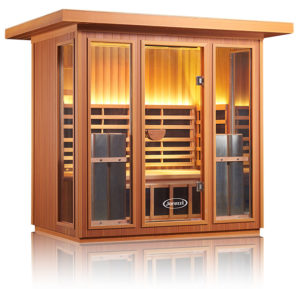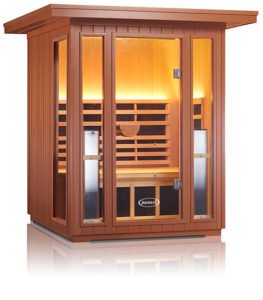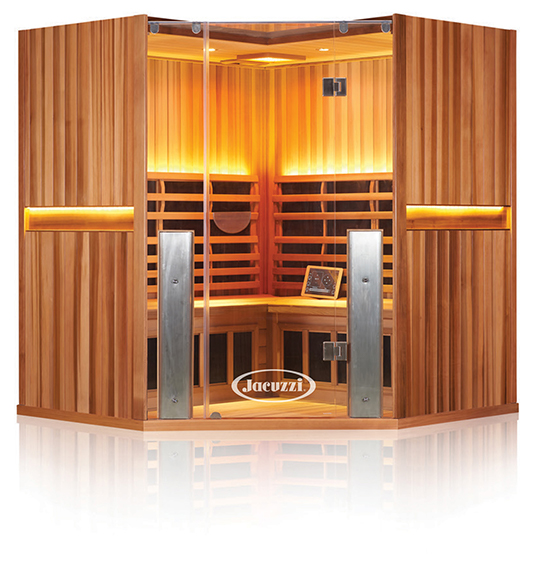Because of Frederick William Hershel's discovery in 1800, we know that there is a spectrum of light we cannot see that produces heat hotter than any color we can. Meaning, this heat can effectively be pointed like light (which it is). This spawned the first investigation of light saunas by Dr. JH Kellogg.
Written by Christopher Kiggins
The first time I heard the phrase infrared sauna I immediately thought of science fiction sauna. My mind flashed to infrared goggles and how they were part of a sauna? I literally had no idea infrared means heat as well as light.
I don’t think I’m alone in this thought, but while infrared saunas may seem like a very modern concept to people like myself, who in the past 20 years or so have just now started to use them, they actually date back quite a ways.
As I’ve talked about in the introduction, infrared saunas have helped me conquer personal health problems that range from high blood pressure to insomnia, and they’ve helped thousands of people I’ve talked to as well.
To understand how infrared saunas have become such a valuable part of people’s everyday lives, I think it’s important to be familiar with where the concept of a sauna and the technology originally comes from.
As you can imagine, infrared saunas weren’t possible until the advent of electricity; however, the basic premise of a sauna—using heat for its healing properties and ability to cause a cleansing sweat—has been around for an incredibly long time.
Over two-thousand years ago, the Greek physician Parmenides said, “Give me the power to create fever, and I will cure any disease.”
Thousands of years ago, in Mexico and Guatemala, indigenous peoples used something called a Temazcal as a kind of dry sauna. Temazcales were usually permanent structures built of volcanic rock and cement, shaped like a dome.
To produce heat, volcanic stones were warmed with fire and placed in a pit in the center of the room or near one of the walls, warming the interior with a dry, intense heat. After a battle or physically-intense games, participants would enter the Temazcal as part of a curative ceremony to cleanse and heal the body following the physical rigors.
Athletes still use saunas this way today; even I can relate. After I swim or play tennis, I love spending 30 to 40 minutes giving my muscles well needed relief. In other parts of the Western Hemisphere, Native Americans used sweat lodges—a counterpart to today’s steam saunas—as part of their spiritual ceremonies.
Native Americans weren’t the only ones to find spiritual aspects in saunas; across the Atlantic in Estonia, steam saunas were also being used as part of spiritual ceremonies. But it was not far from Estonia—just across the gulf of Finland—that the steam saunas that are popular across the world today developed.
In Finland, the first saunas featured fireplaces and stones that were heated to extreme temperatures before having water thrown over them to generate steam. When the Finnish people began to later migrate to other parts of the globe, they brought their sauna traditions with them. If you’ve ever been a member of a health club, or spent time at a fancy hotel, you’ve surely seen a traditional steam sauna that grew out of the long Finnish sauna tradition. Even the method of heating stones, and pouring water over them to create steam, is the same—though now those stones are heated using electricity rather than a fire.
Something I always found interesting was that these ancient Finnish style saunas were originally created to bathe with warm water.
Temazcal: A permanent structure found in the highlands of Central and Southern Mexico and Guatemala, usually made of clay and used by athletes or warriors to heal and cleanse their bodies after intense exertion.
Sweat Lodge: A transient structure built by the Native Americans. Sweat lodges are believed to have been used for spiritual reasons rather than for healing. Sweat lodges were usually made of saplings and covered with blankets or animal skins. The sweat lodge used steam to heat its interior.
Estonian Saunas: Similar to Finnish saunas, but like the Native Americans, Estonians also used the saunas for spiritual reasons and in rituals. Estonian saunas used steam and were very close cousins to the Finnish sauna.
Finnish Saunas: This type of sauna is now found in many gyms and hotels throughout the world. The oldest saunas in Finland used pits dug into the slope of the ground, with a fireplace and stones heated to high temperatures. Water was thrown onto the stones to create steam. Besides raising core body temperature, the Finnish sauna was also a very early hot shower or bathing room.
Now we know where the history of traditional and steam saunas came from. However, if you are like me and you have experienced benefits from infrared saunas or you are interested in starting infrared sauna therapy, you probably want to know when infrared technology entered the sauna game.
It was actually all the way back in the year 1800 when a man named Frederick William Herschel first discovered infrared rays. Herschel held a prism up to sunlight and noted the refraction of light in the prism. During this experiment, Herschel noted that filters of different colors seemed to pass different amounts of heat. Herschel thought the colors themselves might be of varying temperatures. So he devised a clever experiment to investigate his hypothesis.
He directed sunlight through a glass prism to create a spectrum and them measured the temperature of each color.
Herschel used three blacked-bulb thermometers to measure each color of the spectrum. As he measured the temperatures of each color he noticed all of the colors had temperatures higher than the controls. Additionally, he found that the temperatures of the colors increased from violet to red (with red being hotter than violet). After noticing this pattern, Herschel decided to measure the temperature just beyond the red portion of the color spectrum in a region where no sunlight was visible. To his surprise, he found that this region had the highest temperature! In doing so he discovered a type of light that we cannot see with our eyes!
This was the earliest research into what we would later come to know as infrared light (‘infra’ red light means light that is below red on the spectrum—infra means below in Latin).
Herschel published his early studies of this concept with the Royal Society of London in 1800. A quick side note—Herschel also happened to discover Uranus! No, I’m serious. He discovered the planet in 1781.
Over the 1800’s, research into infrared light continued to gradually evolve, with scientists learning more and more about what it was and how it functioned. The connection to saunas, however, wasn’t made until about 100 years ago, when Dr. JH Kellogg of Battle Creek Michigan invented something that he called an electric light bath.
The sauna cabinet, which Kellogg first displayed a version of at the 1893 World’s Fair in Chicago, was sold all over the globe, with some reports saying that German doctors used the technology to cure the King of England of gout, a development that led to the King having the light bath installed in Buckingham Palace.
Drawings of Dr. Kellogg’s product from this time period look similar to near infrared saunas that are available today. The bulbs inside Kellogg’s cabinet generate incandescent light that is rich with near infrared rays that penetrate the skin and raise the body temperature, creating a similar effect as a steam sauna without humidity.
The technology for far infrared saunas, which are the variety that I personally swear by, wouldn’t come until many years later. In the 1960’s NASA had been doing research into far infrared for the space program, and had discovered how to produce far infrared rays. It was a Japanese doctor, Dr. Tadashi Ishikawa, who received the first patent in 1965 for a ceramic far infrared heater, which he began to use for healing in the same way one would use a near infrared or traditional steam sauna.
Until this point, no one had been using far infrared heat in a sauna setting. For the next 14 years, doctors in Japan were the only ones using this technology, until 1979, when the product was finally released for public use. The technology eventually came to the United States in the 1980’s, and it has continued to be refined and made more effective since then.
I am glad infrared saunas have developed the way they have, because I couldn’t imagine my life without the benefits they provide, like deep sleep, lower blood pressure, less joint pain, weight loss, and a boosted immune system. Here at SaunaCloud I sell saunas that are some of the best history has offered. My far infrared saunas use advanced ceramic-carbon combination heaters for an amazing sauna experience. For more information on how SaunaCloud’s infrared saunas work and how they can improve your health, download my book The Definitive Guide to Infrared Saunas. Just give us a call at SaunaCloud 1.800.370.0820.
If you enjoyed this page, please share it below ↓ Thanks for reading,
Facebook
Twitter
LinkedIn
Reddit

Christopher Kiggins | Sauna Enthusiast
I have been writing, learning, educating and generally pointing people in the right direction infrared sauna wise since 2012. Let me know how I can help: chris@saunacloud.com - (530) 417-1220




